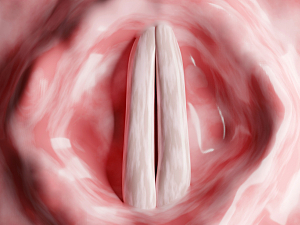Several injectable substances are available to treat glottic insufficiency (GI). Carboxymethylcellulose and calcium hydroxyapatite are both FDA-approved for vocal fold injection augmentation (VFIA) while facial fillers made from cross-linked hyaluronic acid (HA) are often used but off-label. Although safe, these materials are eventually resorbed.
Silk–HA (Silk Voice, Sofregen Medical) was cleared by the FDA in 2019 for augmenting vocal fold tissue to improve glottic insufficiency. Silk-HA is commonly delivered trans-nasally through the working channel of a flexible laryngoscope using a proprietary catheter but can be delivered through traditional per-oral and transcutaneous routes.
In the Journal of Voice, Christopher D. Dwyer, MD, laryngologist in the Division of Otolaryngology-Head and Neck Surgery at Brigham and Women’s Hospital, Thomas L. Carroll, MD, director of the Brigham’s Voice Program and section chief of Laryngology, and colleagues present the first publication to describe the use of silk–HA in patients, including clinical pearls and suggestions for the informed consent process.
Patient Characteristics
The authors reviewed the charts of 58 consecutive patients who underwent VFIA with silk-HA by Dr. Carroll between July 2020 and December 2021. Their mean age was 64 (range, 21–88). Nine patients had bilateral injections. The predominant cause of GI was unilateral vocal fold paralysis (UVFP; 67%). Twenty-seven patients had been previously treated for GI.
Nine patients were lost to follow-up without any subsequent outpatient visit. The timing of the most recent follow-up visit ranged from seven to 560 days (mean, 190 days).
Voice Outcomes
Both pre-procedure and three-month scores on the Voice Handicap Index-10 (VHI-10) were available for 10 patients, all of whom underwent silk-HA injection for UVFP. The mean improvement was −14.6 points (P=0.0013), substantially more than the minimal clinically important difference established for UVFP, −4 points.
Voice recordings at both the pre-procedure and three-month time points were available for 10 patients (a different subset than the 10 patients with VHI-10 scores, although with some overlap). The mean improvement in the Consensus Auditory–Perceptual Evaluation of Voice score was −33 points (P<0.0001).
Complications
Eight patients sought medical advice for symptomatic dyspnea. Four contacted the surgical team, were deemed to have mild dyspnea, and were offered oral corticosteroids.
The other four patients presented to the emergency department. One with known inducible laryngeal obstruction–paradoxical vocal fold motion was discharged without intervention after normal laryngoscopy. One with known bilateral vocal fold motion impairment (paralysis + paresis) was treated with an outpatient course of prednisone. The other two had laryngoscopic evidence of severe hemi-laryngeal edema on the side of the injection involving the supraglottis. Both had a history of head and neck cancer, status post neck dissection, and/or adjuvant radiotherapy. They were admitted and treated with IV and then oral corticosteroids, with rapid resolution in 24–48 hours.
Thus, the rate of major complications requiring admission was 3.4%, comparable to other commercially marketed materials.
Repeat Injection
Thirteen patients (22%) required a second injection for ongoing dysphonia attributed to persistent GI. It remains unclear whether this was due to the true gradual loss of augmentation material, under-augmentation during the initial procedure, or unaddressed contralateral vocal pathology.
The Brigham Experience
The authors offer guidance to other clinicians who may wish to try silk-HA:
- Counsel patients about the risk of post-injection dyspnea requiring medical attention and the potential for severe airway edema requiring medical treatment
- When patients need bilateral injections, other than for vocal fold atrophy or scar with normal bilateral vocal fold motion, offer a two-stage procedure, three months apart; alternatively, make sure the consent form mentions the risk of edema and prescribe high-dose corticosteroids to be started the day of the injection or, at minimum, at the start of any dyspneic symptoms
- Prepare patients to feel short-term discomfort/pain from needle insertion (the needle required for silk-HA is 21-gauge)
- A good first patient to try has left vocal fold paralysis without significant arytenoid overhang and otherwise normal anatomy; the left vocal fold is easier to visualize during injection than the right fold when using most standard, channel laryngoscopes
The authors now routinely use stroboscopy in real-time during injection, often during phonation, while the needle remains trans-nasally inserted into the vocal fold. They believe this may decrease the need for reinjection, but that remains to be determined with longer follow-up.
Dr. Carroll discloses within the text that he is a consultant to Pentax Medical, which markets silk-HA, and a scientific advisor to and shareholder of Sofregen Medical.
